Tetration
In mathematics, tetration (or hyper-4) is an operation based on iterated, or repeated, exponentiation. It is the next hyperoperation after exponentiation, but before pentation. The word was coined by Reuben Louis Goodstein from tetra- (four) and iteration.

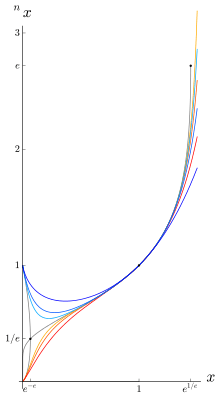
Under the definition as repeated exponentiation, the notation means , where n copies of a are iterated via exponentiation, right-to-left, I.e. the application of exponentiation times. n is called the "height" of the function, while a is called the "base," analogous to exponentiation. It would be read as "the nth tetration of a".
Tetration is also defined recursively as
- ,
allowing for attempts to extend tetration to non-natural numbers such as real and complex numbers.
The two inverses of tetration are called the super-root and the super-logarithm, analogous to the nth root and the logarithmic functions. None of the three functions are elementary.
Tetration is used for the notation of very large numbers.
Introduction
The first four hyperoperations are shown here, with tetration being considered the fourth in the series. The unary operation succession, defined as , is considered to be the zeroth operation.
- Addition
-
- n copies of 1 added to a.
-
- Multiplication
-
- n copies of a combined by addition.
-
- Exponentiation
-
- n copies of a combined by multiplication.
-
- Tetration
-
- n copies of a combined by exponentiation, right-to-left.[1]
-
Succession, (a′ = a + 1), is the most basic operation; while addition (a + n) is a primary operation, for addition of natural numbers it can be thought of as a chained succession of n successors of a; multiplication (a × n) is also a primary operation, though for natural numbers it can analogously be thought of as a chained addition involving n numbers of a. Exponentiation can be thought of as a chained multiplication involving n numbers of a and tetration () as a chained power involving n numbers a. Each of the operations above are defined by iterating the previous one;[2] however, unlike the operations before it, tetration is not an elementary function.
The parameter a is referred to as the base, while the parameter n may be referred to as the height. In the original definition of tetration, the height parameter must be a natural number; for instance, it would be illogical to say "three raised to itself negative five times" or "four raised to itself one half of a time." However, just as addition, multiplication, and exponentiation can be defined in ways that allow for extensions to real and complex numbers, several attempts have been made to generalize tetration to negative numbers, real numbers, and complex numbers. One such way for doing so is using a recursive definition for tetration; for any positive real and non-negative integer , we can define recursively as:[2]
The recursive definition is equivalent to repeated exponentiation for natural heights; however, this definition allows for extensions to the other heights such as , , and as well – many of these extensions are areas of active research.
Terminology
There are many terms for tetration, each of which has some logic behind it, but some have not become commonly used for one reason or another. Here is a comparison of each term with its rationale and counter-rationale.
- The term tetration, introduced by Goodstein in his 1947 paper Transfinite Ordinals in Recursive Number Theory[3] (generalizing the recursive base-representation used in Goodstein's theorem to use higher operations), has gained dominance. It was also popularized in Rudy Rucker's Infinity and the Mind.
- The term superexponentiation was published by Bromer in his paper Superexponentiation in 1987.[4] It was used earlier by Ed Nelson in his book Predicative Arithmetic, Princeton University Press, 1986.
- The term hyperpower[5] is a natural combination of hyper and power, which aptly describes tetration. The problem lies in the meaning of hyper with respect to the hyperoperation sequence. When considering hyperoperations, the term hyper refers to all ranks, and the term super refers to rank 4, or tetration. So under these considerations hyperpower is misleading, since it is only referring to tetration.
- The term power tower[6] is occasionally used, in the form "the power tower of order n" for . This is a misnomer, however, because tetration cannot be expressed with iterated power functions (see above), since it is an iterated exponential function.
Owing in part to some shared terminology and similar notational symbolism, tetration is often confused with closely related functions and expressions. Here are a few related terms:
| Terminology | Form |
|---|---|
| Tetration | |
| Iterated exponentials | |
| Nested exponentials (also towers) | |
| Infinite exponentials (also towers) |
In the first two expressions a is the base, and the number of times a appears is the height (add one for x). In the third expression, n is the height, but each of the bases is different.
Care must be taken when referring to iterated exponentials, as it is common to call expressions of this form iterated exponentiation, which is ambiguous, as this can either mean iterated powers or iterated exponentials.
Notation
There are many different notation styles that can be used to express tetration. Some notations can also be used to describe other hyperoperations, while some are limited to tetration and have no immediate extension.
| Name | Form | Description |
|---|---|---|
| Rudy Rucker notation | Used by Maurer [1901] and Goodstein [1947]; Rudy Rucker's book Infinity and the Mind popularized the notation.[nb 1] | |
| Knuth's up-arrow notation | Allows extension by putting more arrows, or, even more powerfully, an indexed arrow. | |
| Conway chained arrow notation | Allows extension by increasing the number 2 (equivalent with the extensions above), but also, even more powerfully, by extending the chain | |
| Ackermann function | Allows the special case to be written in terms of the Ackermann function. | |
| Iterated exponential notation | Allows simple extension to iterated exponentials from initial values other than 1. | |
| Hooshmand notations[7] | Used by M. H. Hooshmand [2006]. | |
| Hyperoperation notations | Allows extension by increasing the number 4; this gives the family of hyperoperations. | |
| Double caret notation | a^^n |
Since the up-arrow is used identically to the caret (^), tetration may be written as (^^); convenient for ASCII. |
One notation above uses iterated exponential notation; this is defined in general as follows:
- with n as.
There are not as many notations for iterated exponentials, but here are a few:
| Name | Form | Description |
|---|---|---|
| Standard notation | Euler coined the notation , and iteration notation has been around about as long. | |
| Knuth's up-arrow notation | Allows for super-powers and super-exponential function by increasing the number of arrows; used in the article on large numbers. | |
| Text notation | exp_a^n(x) |
Based on standard notation; convenient for ASCII. |
| J Notation | x^^:(n-1)x |
Repeats the exponentiation. See J (programming language)[8] |
Examples
Because of the extremely fast growth of tetration, most values in the following table are too large to write in scientific notation. In these cases, iterated exponential notation is used to express them in base 10. The values containing a decimal point are approximate.
| 1 | 1 | 1 | 1 | 1 |
|---|---|---|---|---|
| 2 | 4 | 16 | 65,536 | 265,536 or (2.00353 × 1019,728) |
| 3 | 27 | 7,625,597,484,987 | (3.6 × 1012 digits) | |
| 4 | 256 | 1.34078 × 10154 | (8.1 × 10153 digits) | |
| 5 | 3,125 | 1.91101 × 102,184 | (1.3 × 102,184 digits) | |
| 6 | 46,656 | 2.65912 × 1036,305 | (2.1 × 1036,305 digits) | |
| 7 | 823,543 | 3.75982 × 10695,974 | (3.2 × 10695,974 digits) | |
| 8 | 16,777,216 | 6.01452 × 1015,151,335 | (5.4 × 1015,151,335 digits) | |
| 9 | 387,420,489 | 4.28125 × 10369,693,099 | (4.1 × 10369,693,099 digits) | |
| 10 | 10,000,000,000 | 1010,000,000,000 | (101010+1 digits) |
Properties
Tetration has several properties that are similar to exponentiation, as well as properties that are specific to the operation and are lost or gained from exponentiation. Because exponentiation does not commute, the product and power rules do not have an analogue with tetration; the statements and are not necessarily true for all cases.[9]
However, tetration does follow a different property, in which . This fact is most clearly shown using the recursive definition. From this property, a proof follows that , which allows for switching b and c in certain equations. The proof goes as follows:
When a number x and 10 are coprime, it is possible to compute the last m decimal digits of using Euler's theorem, for any integer m.
Direction of evaluation
When evaluating tetration expressed as an "exponentiation tower", the serial exponentiation is done at the deepest level first (in the notation, at the apex).[1] For example:
This order is important because exponentiation is not associative, and evaluating the expression in the opposite order will lead to a different answer:
Evaluating the expression the left to right is considered less interesting; evaluating left to right, any expression can be simplified to be .[10] Because of this, the towers must be evaluated from right to left (or top to bottom). Computer programmers refer to this choice as right-associative.
Extensions
Tetration can be extended in two different ways; in the equation , both the base a and the height n can be generalized using the definition and properties of tetration. Although the base and the height can be extended beyond the non-negative integers to different domains, including , complex functions such as , and heights of infinite n, the more limited properties of tetration reduce the ability to extend tetration.
Extension of domain for bases
Base zero
The exponential is not consistently defined. Thus, the tetrations are not clearly defined by the formula given earlier. However, is well defined, and exists:[11]
Thus we could consistently define . This is analogous to defining .
Under this extension, , so the rule from the original definition still holds.
Complex bases

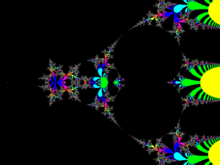
Since complex numbers can be raised to powers, tetration can be applied to bases of the form z = a + bi (where a and b are real). For example, in nz with z = i, tetration is achieved by using the principal branch of the natural logarithm; using Euler's formula we get the relation:
This suggests a recursive definition for n+1i = a′ + b′i given any ni = a + bi:
The following approximate values can be derived:
| Approximate value | |
|---|---|
| i | |
| 0.2079 | |
| 0.9472 + 0.3208i | |
| 0.0501 + 0.6021i | |
| 0.3872 + 0.0305i | |
| 0.7823 + 0.5446i | |
| 0.1426 + 0.4005i | |
| 0.5198 + 0.1184i | |
| 0.5686 + 0.6051i |
Solving the inverse relation, as in the previous section, yields the expected 0i = 1 and −1i = 0, with negative values of n giving infinite results on the imaginary axis. Plotted in the complex plane, the entire sequence spirals to the limit 0.4383 + 0.3606i, which could be interpreted as the value where n is infinite.
Such tetration sequences have been studied since the time of Euler, but are poorly understood due to their chaotic behavior. Most published research historically has focused on the convergence of the infinitely iterated exponential function. Current research has greatly benefited by the advent of powerful computers with fractal and symbolic mathematics software. Much of what is known about tetration comes from general knowledge of complex dynamics and specific research of the exponential map.
Extensions of the domain for different heights
Infinite heights
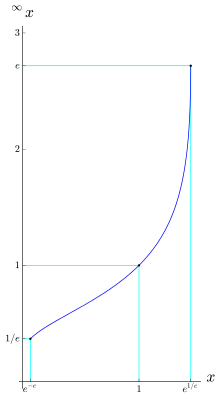
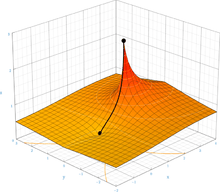
Tetration can be extended to infinite heights;[12] i.e., for certain a and n values in , there exists a well defined result for an infinite n. This is because for bases within a certain interval, tetration converges to a finite value as the height tends to infinity. For example, converges to 2, and can therefore be said to be equal to 2. The trend towards 2 can be seen by evaluating a small finite tower:
In general, the infinitely iterated exponential , defined as the limit of as n goes to infinity, converges for e−e ≤ x ≤ e1/e, roughly the interval from 0.066 to 1.44, a result shown by Leonhard Euler.[13] The limit, should it exist, is a positive real solution of the equation y = xy. Thus, x = y1/y. The limit defining the infinite tetration of x fails to converge for x > e1/e because the maximum of y1/y is e1/e.
This may be extended to complex numbers z with the definition:
where W represents Lambert's W function.
As the limit y = ∞x (if existent, i.e. for e−e < x < e1/e) must satisfy xy = y we see that x ↦ y = ∞x is (the lower branch of) the inverse function of y ↦ x = y1/y.
Negative heights
We can use the recursive rule for tetration,
to prove :
Substituting −1 for k gives
- .[10]
Smaller negative values cannot be well defined in this way. Substituting −2 for k in the same equation gives
which is not well defined. They can, however, sometimes be considered sets.[10]
For , any definition of is consistent with the rule because
- for any .
Real heights
At this time there is no commonly accepted solution to the general problem of extending tetration to the real or complex values of n. There have, however, been multiple approaches towards the issue, and different approaches are outlined below.
In general, the problem is finding — for any real a > 0 — a super-exponential function over real x > −2 that satisfies
- for all real [14]
To find a more natural extension, one or more extra requirements are usually required. This is usually some collection of the following:
- A continuity requirement (usually just that is continuous in both variables for ).
- A differentiability requirement (can be once, twice, k times, or infinitely differentiable in x).
- A regularity requirement (implying twice differentiable in x) that:
- for all
The fourth requirement differs from author to author, and between approaches. There are two main approaches to extending tetration to real heights; one is based on the regularity requirement, and one is based on the differentiability requirement. These two approaches seem to be so different that they may not be reconciled, as they produce results inconsistent with each other.
When is defined for an interval of length one, the whole function easily follows for all x > −2.
Linear approximation for real heights

A linear approximation (solution to the continuity requirement, approximation to the differentiability requirement) is given by:
hence:
| Approximation | Domain |
|---|---|
| for −1 < x < 0 | |
| for 0 < x < 1 | |
| for 1 < x < 2 |
and so on. However, it is only piecewise differentiable; at integer values of x the derivative is multiplied by . It is continuously differentiable for if and only if . For example, using these methods and
A main theorem in Hooshmand's paper[7] states: Let . If is continuous and satisfies the conditions:
- is differentiable on (−1, 0),
- is a nondecreasing or nonincreasing function on (−1, 0),
then is uniquely determined through the equation
where denotes the fractional part of x and is the -iterated function of the function .
The proof is that the second through fourth conditions trivially imply that f is a linear function on [−1, 0].
The linear approximation to natural tetration function is continuously differentiable, but its second derivative does not exist at integer values of its argument. Hooshmand derived another uniqueness theorem for it which states:
If is a continuous function that satisfies:
- is convex on (−1, 0),
then . [Here is Hooshmand's name for the linear approximation to the natural tetration function.]
The proof is much the same as before; the recursion equation ensures that and then the convexity condition implies that is linear on (−1, 0).
Therefore, the linear approximation to natural tetration is the only solution of the equation and which is convex on (−1, +∞). All other sufficiently-differentiable solutions must have an inflection point on the interval (−1, 0).
Higher order approximations for real heights
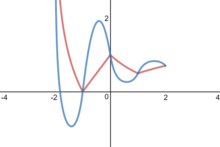
Beyond linear approximations, a quadratic approximation (to the differentiability requirement) is given by:
which is differentiable for all , but not twice differentiable. For example, If this is the same as the linear approximation.[2]
Because of the way it is calculated, this function does not "cancel out", contrary to exponents, where . Namely,
- .
Just as there is a quadratic approximation, cubic approximations and methods for generalizing to approximations of degree n also exist, although they are much more unwieldy.[2][15]
Complex heights

It has now been proven[16] that there exists a unique function F which is a solution of the equation F(z + 1) = exp(F(z)) and satisfies the additional conditions that F(0) = 1 and F(z) approaches the fixed points of the logarithm (roughly 0.318 ± 1.337i) as z approaches ±i∞ and that F is holomorphic in the whole complex z-plane, except the part of the real axis at z ≤ −2. This proof confirms a previous conjecture.[17] The construction of such a function was originally demonstrated by Kneser in 1950.[18] The complex map of this function is shown in the figure at right. The proof also works for other bases besides e, as long as the base is bigger than . Subsequent work extended the construction to all complex bases. The complex double precision approximation of this function is available online.[19]
The requirement of the tetration being holomorphic is important for its uniqueness. Many functions S can be constructed as
where α and β are real sequences which decay fast enough to provide the convergence of the series, at least at moderate values of Im z.
The function S satisfies the tetration equations S(z + 1) = exp(S(z)), S(0) = 1, and if αn and βn approach 0 fast enough it will be analytic on a neighborhood of the positive real axis. However, if some elements of {α} or {β} are not zero, then function S has multitudes of additional singularities and cutlines in the complex plane, due to the exponential growth of sin and cos along the imaginary axis; the smaller the coefficients {α} and {β} are, the further away these singularities are from the real axis.
The extension of tetration into the complex plane is thus essential for the uniqueness; the real-analytic tetration is not unique.
Non-elementary recursiveness
Tetration (restricted to ) is not an elementary recursive function. One can prove by induction that for every elementary recursive function f, there is a constant c such that
We denote the right hand side by . Suppose on the contrary that tetration is elementary recursive. is also elementary recursive. By the above inequality, there is a constant c such that . By letting , we have that , a contradiction.
Inverse operations
Exponentiation has two inverse operations; roots and logarithms. Analogously, the inverses of tetration are often called the super-root, and the super-logarithm (In fact, all hyperoperations greater than or equal to 3 have analogous inverses); e.g., in the function , the two inverses are the cube super-root of y and the super logarithm base y of x.
Super-root
The super-root is the inverse operation of tetration with respect to the base: if , then y is an nth super root of x ( or ).
For example,
so 2 is the 4th super-root of 65,536.
Square super-root
.png)
The 2nd-order super-root, square super-root, or super square root has two equivalent notations, and . It is the inverse of and can be represented with the Lambert W function:[20]
The function also illustrates the reflective nature of the root and logarithm functions as the equation below only holds true when :
Like square roots, the square super-root of x may not have a single solution. Unlike square roots, determining the number of square super-roots of x may be difficult. In general, if , then x has two positive square super-roots between 0 and 1; and if , then x has one positive square super-root greater than 1. If x is positive and less than it doesn't have any real square super-roots, but the formula given above yields countably infinitely many complex ones for any finite x not equal to 1.[20] The function has been used to determine the size of data clusters.[21]
At :
Other super-roots
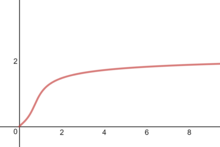
For each integer n > 2, the function nx is defined and increasing for x ≥ 1, and n1 = 1, so that the nth super-root of x, , exists for x ≥ 1.
However, if the linear approximation above is used, then if −1 < y ≤ 0, so cannot exist.
In the same way as the square super-root, terminology for other super roots can be based on the normal roots: "cube super-roots" can be expressed as ; the "4th super-root" can be expressed as ; and the "nth super-root" is . Note that may not be uniquely defined, because there may be more than one nth root. For example, x has a single (real) super-root if n is odd, and up to two if n is even.
Just as with the extension of tetration to infinite heights, the super-root can be extended to n = ∞, being well-defined if 1/e ≤ x ≤ e. Note that and thus that . Therefore, when it is well defined, and, unlike normal tetration, is an elementary function. For example, .
It follows from the Gelfond–Schneider theorem that super-root for any positive integer n is either integer or transcendental, and is either integer or irrational.[22] It is still an open question whether irrational super-roots are transcendental in the latter case.
Super-logarithm
Once a continuous increasing (in x) definition of tetration, xa, is selected, the corresponding super-logarithm or is defined for all real numbers x, and a > 1.
The function sloga x satisfies:
Open questions
Other than the problems with the extensions of tetration, there are several open questions concerning tetration, particularly when concerning the relations between number systems such as integers and irrational numbers:
- It is not known whether there is a positive integer n for which nπ or ne is an integer. In particular, it is not known whether either of 4π or 5e is an integer.
- It is not known whether nq is an integer for any positive integer n and positive non-integer rational q.[22] Particularly, it is not known whether the positive root of the equation 4x = 2 is a rational number.
See also
| Wikimedia Commons has media related to tetration. |
Notes
- Rudolf von Bitter Rucker's (1982) notation nx, as introduced by Hans Maurer (1901) and Reuben Louis Goodstein (1947) for tetration, must not be confused with Alfred Pringsheim's and Jules Molk's (1907) notation nf(x) to denote iterated function compositions.
References
- "Derivative of $x^x$, $x^{x^x}$, and a Venture Into Tetration and Hyper-Exponentiation". Math Vault. 2016-01-01. Retrieved 2019-07-25.
- Neyrinck, Mark. An Investigation of Arithmetic Operations. Retrieved 9 January 2019.
- R. L. Goodstein (1947). "Transfinite ordinals in recursive number theory". Journal of Symbolic Logic. 12 (4): 123–129. doi:10.2307/2266486. JSTOR 2266486.
- N. Bromer (1987). "Superexponentiation". Mathematics Magazine. 60 (3): 169–174. doi:10.1080/0025570X.1987.11977296. JSTOR 2689566.
- J. F. MacDonnell (1989). "Somecritical points of the hyperpower function ". International Journal of Mathematical Education. 20 (2): 297–305. doi:10.1080/0020739890200210. MR 0994348.
- Weisstein, Eric W. "Power Tower". MathWorld.
- M. H. Hooshmand (2006). "Ultra power and ultra exponential functions". Integral Transforms and Special Functions. 17 (8): 549–558. doi:10.1080/10652460500422247.
- "Power Verb". J Vocabulary. J Software. Retrieved 2011-10-28.
- Alexander Meiburg. (2014). Analytic Extension of Tetration Through the Product Power-Tower Retrieved November 29, 2018
- Müller, M. "Reihenalgebra: What comes beyond exponentiation?" (PDF). Retrieved 2018-12-12.
- "Climbing the ladder of hyper operators: tetration « Stack Exchange Mathematics Blog". math.blogoverflow.com. Retrieved 2019-07-25.
- "Climbing the ladder of hyper operators: tetration". George Daccache. 2015-01-05. Retrieved 2016-02-18.
- Euler, L. "De serie Lambertina Plurimisque eius insignibus proprietatibus." Acta Acad. Scient. Petropol. 2, 29–51, 1783. Reprinted in Euler, L. Opera Omnia, Series Prima, Vol. 6: Commentationes Algebraicae. Leipzig, Germany: Teubner, pp. 350–369, 1921. (facsimile)
- Trappmann, Henryk; Kouznetsov, Dmitrii (2010-06-28). "5+ methods for real analytic tetration". Retrieved 2018-12-05.
- Andrew Robbins. Solving for the Analytic Piecewise Extension of Tetration and the Super-logarithm. The extensions are found in part two of the paper, "Beginning of Results".
- W. Paulsen and S. Cowgill (March 2017). "Solving in the complex plane" (PDF). Advances in Computational Mathematics. 43: 1–22. doi:10.1007/s10444-017-9524-1.
- D. Kouznetsov (July 2009). "Solution of in complex -plane" (PDF). Mathematics of Computation. 78 (267): 1647–1670. doi:10.1090/S0025-5718-09-02188-7.
- H.Kneser (1950). "Reelle analytische Losungen der Gleichung und verwandter Funktionalgleichungen". Journal für die reine und angewandte Mathematik. 187: 56–67.
- W. Paulsen (June 2018). "Tetration for complex bases". Advances in Computational Mathematics. 45: 243–267. doi:10.1007/s10444-018-9615-7.
- Corless, R. M.; Gonnet, G. H.; Hare, D. E. G.; Jeffrey, D. J.; Knuth, D. E. (1996). "On the Lambert W function" (PostScript). Advances in Computational Mathematics. 5: 333. arXiv:1809.07369. doi:10.1007/BF02124750.
- Krishnam R. (2004), "Efficient Self-Organization Of Large Wireless Sensor Networks" - Dissertation, BOSTON UNIVERSITY, COLLEGE OF ENGINEERING. pp. 37–40
- Marshall, Ash J., and Tan, Yiren, "A rational number of the form aa with a irrational", Mathematical Gazette 96, March 2012, pp. 106–109.
- Daniel Geisler, Tetration
- Ioannis Galidakis, On extending hyper4 to nonintegers (undated, 2006 or earlier) (A simpler, easier to read review of the next reference)
- Ioannis Galidakis, On Extending hyper4 and Knuth's Up-arrow Notation to the Reals (undated, 2006 or earlier).
- Robert Munafo, Extension of the hyper4 function to reals (An informal discussion about extending tetration to the real numbers.)
- Lode Vandevenne, Tetration of the Square Root of Two, (2004). (Attempt to extend tetration to real numbers.)
- Ioannis Galidakis, Mathematics, (Definitive list of references to tetration research. Lots of information on the Lambert W function, Riemann surfaces, and analytic continuation.)
- Joseph MacDonell, Some Critical Points of the Hyperpower Function.
- Dave L. Renfro, Web pages for infinitely iterated exponentials
- Knobel R (1981). "Exponentials Reiterated". American Mathematical Monthly. 88 (4): 235–252. doi:10.1080/00029890.1981.11995239.
- Hans Maurer, "Über die Funktion für ganzzahliges Argument (Abundanzen)." Mittheilungen der Mathematische Gesellschaft in Hamburg 4, (1901), p. 33–50. (Reference to usage of from Knobel's paper.)
- The Fourth Operation
- Luca Moroni, The strange properties of the infinite power tower (https://arxiv.org/abs/1908.05559)
Further reading
- Galidakis, Ioannis and Weisstein, Eric W. "Power Tower". MathWorld. Retrieved 2019-07-05.CS1 maint: multiple names: authors list (link)